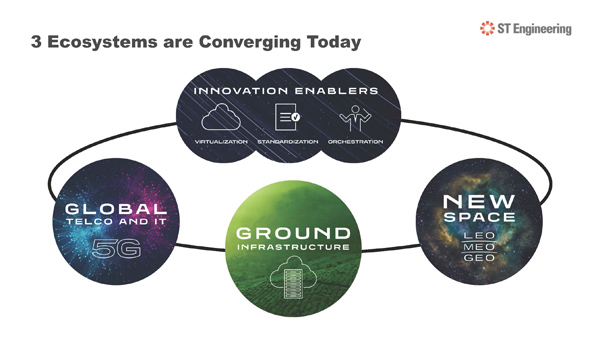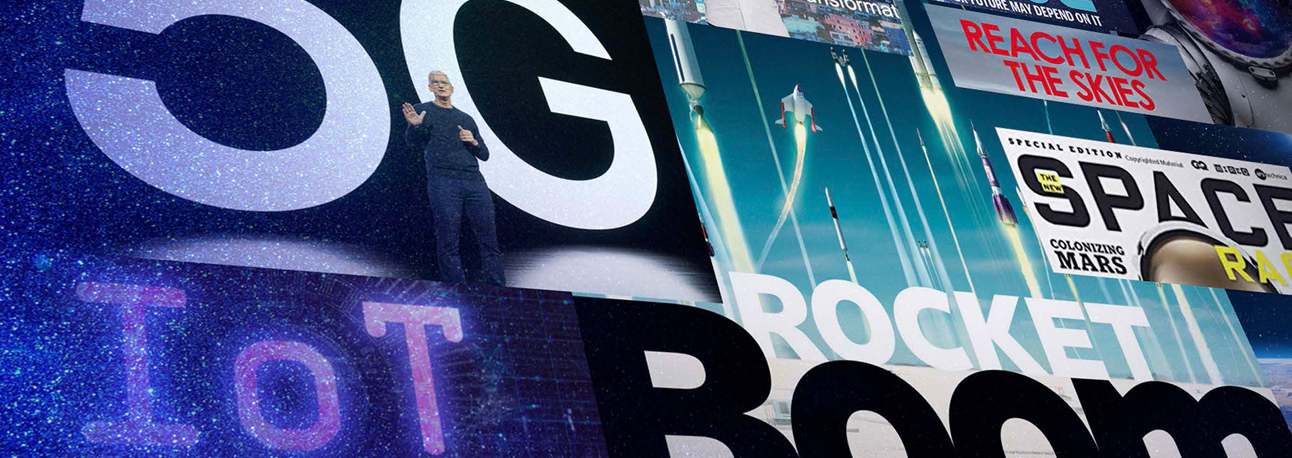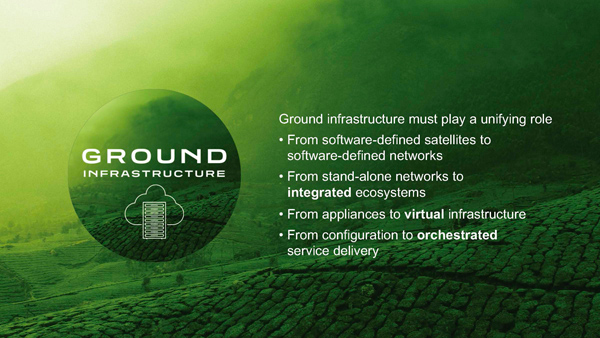We spend a lot of time thinking about what’s going on in space, and that’s perfectly natural – we are in the satellite industry after all. But we’re moving towards a time where we need to look at the bigger picture. Ecosystems in the space, telco and IT industries are coming together being driven by the advent of 5G and its promise to connect everything, everywhere.
We know that the satellite industry is evolving fast. New Space, the development of satellite design and introduction of mega constellations comprising satellites with dynamic beams and flexible payloads, is set to revolutionize the way space sector does business. But the essential component in all of this is the ground segment, which will tie these innovations together. It’s perfect timing from our industry perspective and it brings forth a multitude of innovation.
Space and 5G Innovation
 If we focus on space first, we are in the midst of possibly the largest transformation in our satellite industry. This encompasses a lot of new elements, new capabilities and new innovations in space. It’s extremely important that our industry now figures out how we take advantage of this. Satellites now have terabit levels of capacity. Then there are new LEO constellations with hundreds and even thousands of high capacity satellites that form a network together. It’s here that orchestration of capacity resources and synchronization with the ground segment becomes critical. These are both important elements, but another important aspect to note is that the satellites are also becoming more capable. Whilst they used to be static, with an unmoving beam and custom built to serve regions and applications, today they feature standardized, fully programmable and fully digitized payloads.
If we focus on space first, we are in the midst of possibly the largest transformation in our satellite industry. This encompasses a lot of new elements, new capabilities and new innovations in space. It’s extremely important that our industry now figures out how we take advantage of this. Satellites now have terabit levels of capacity. Then there are new LEO constellations with hundreds and even thousands of high capacity satellites that form a network together. It’s here that orchestration of capacity resources and synchronization with the ground segment becomes critical. These are both important elements, but another important aspect to note is that the satellites are also becoming more capable. Whilst they used to be static, with an unmoving beam and custom built to serve regions and applications, today they feature standardized, fully programmable and fully digitized payloads.
Now, let’s take 5G. When we mention 5G, we often think about getting higher speeds to a mobile phone. And whilst that is an element, it’s much more than that. 5G is reshaping and standardizing the way in which we will look at services, how we will deliver services, how we will build services for our customer base. In that sense, 5G is set to become the network of the networks. This will result in a massive push to connect everyone and everything. 5G is the driving force to enable this. Satellite needs to feed into this network of networks, bringing its own unique attributes that will benefit users, especially those that are out of reach of terrestrial infrastructure.
Ground Segment is the Unifier
This brings us to the ground segment and the role that we, as providers, have to play. We are the unifiers – the ones that will enable these changes in space and the advent of 5G. We are now evolving rapidly from static to dynamic networks. As satellites are becoming software defined, we must also move to do the same. That network must then be able to integrate with the overall ecosystem, end-to-end. This also means that we need to move away from the traditional dedicated equipment and appliances to a more virtualized infrastructure just like in the telco world. We have to virtualize the satellite communications infrastructure so that we can easily, automatically and dynamically allocate and deliver resources to our customers. This will come through adoption of the same telco 3GPP and MEF standards and utilize orchestration and virtualization to allow access to the cloud.
These enablers give us the tools we need to deliver what we call the New Ground environment which will bring these ecosystems together.
Real World Use Cases
So, how will we apply these innovations to the real world? Let’s take a look at a couple of examples of use cases.
In the broadband and fixed market, these innovations will aid the perennial challenge of closing the Digital Divide. Bringing connectivity to the unconnected is still a burning issue across EMEA and Asia. The ability to offer cloud services and also IoT over satellite will offer a huge opportunity to those who currently lack terrestrial infrastructure.
In the consumer and enterprise space, access to the cloud is of paramount importance. The global pandemic served to highlight this as remote working became the status quo. In broadcast, OTT content can be delivered in an optimized way. Ground innovations bring scalable throughput and CIR to meet any demand and provide the very best user experience. The key elements are optimization of total cost of ownership (TCO) and bandwidth as well as operational efficiency. The end-to-end service orchestration and seamless integration of satellite into the 5G telco infrastructure will also enable edge computing so that every user can be reached.
In the mobility markets, these developments will be be critical. Service orchestration is essential to deliver the right service at the right time in the right place with the right satellite capacity and this has been a big challenge for mobility. The maritime market is also expected to benefit from the evolution on ground and in space. It has rapidly evolved from being a standalone environment with only limited connectivity to an environment where certain things are now handled remotely and IoT is increasingly used. Cruise ships will benefit from the efficient use of bandwidth resources, enhancing the user experience.
The important point to remember is that these changes and continuous advances in waveform efficiency will allow application-specific solutions to be developed, thus enabling all satcom fixed and mobility markets to be served with a seamless experience.
It’s an exciting time filled with opportunity and innovation, but this new era shines a light on the importance of the ground system as the element that underpins the future of these combined ecosystems. It’s about the interoperability with other with the 5G environment. It’s about the advances in waveform efficient. It’s about cloud-based architectures, virtualization and orchestration of services so that they can be seamlessly and cost-effectively rolled out to any site for any application. And finally, it’s the application specific solutions that add value from the end user perspective.
This is what’s driving us as an innovator and a collaborator – to make the promise of a multi-orbit, multi-access environment a reality for our customers.

